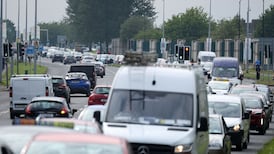JOHN MAJOR insists that Britain's opinion polls are completely wrong. He told yesterday's Sunday Telegraph that Conservative canvass returns are comparable to those in 1992 - when his party defied poll predictions of defeat and went on to win its fourth successive victory. Could the Prime Minister once again be right, and the polls badly adrift.
There are three reasons to discount the Prime Minister's attempts to boost his party's morale with less than two weeks to go to polling day. The first is that the polls are telling a different story from five years ago. Then, they showed the two main parties running neck-and-neck. Around 50 polls were conducted during the campaign; their figures ranged from a Tory lead of 5 per cent to a Labour lead of 7.
Their final polls pointed to a hung parliament, in which neither Labour nor the Tories would win outright. They were wrong: the Tories won by 8 per cent, and obtained an overall 21-seat majority. However, they were not that wrong: they were out, on average, by four points for each of the two main parties.
This time the polls do not indicate a close race. They all put Labour miles ahead. Averaging the three polls in yesterday's newspapers, Labour has 48 per cent the Conservatives 32 and the Liberal Democrats 14. If Mr Major is right about his canvass returns then the polls are not four points wrong, but 11 points wrong. (The Tories won 43 per cent of the vote in 1992.)
Second, the polls have changed their methods since 1992, to try to eliminate the mistakes they made. A post-mortem by the pollsters' trade association, the Market Research Society, found that their samples were all too "downmarket", with too many working-class respondents, and too few middle-class ones. This bias tilted the figures towards Labour. This has now been put right. The pollsters now aim for their samples to contain 47-50 per cent "ABC1s", compared with 39-42 per cent five years ago.
In addition, they have tightened up their sampling procedures. There is some evidence that interviewers were given too much latitude in choosing who to interview and where, and this led to a further slight Labour bias. Now two of the main companies have switched to random-dial telephone polls, while the others have given more precise instructions about interview locations.
The post-mortem also found that some Tory voters were unwilling to admit their allegiance, usually by saying "don't know" to the voting intention question. This has probably continued: when pollsters analyse what the "don't knows" say in response to other questions, it transpires that they are a more Tory inclined group (for example, favouring John Major over Tony Blair as prime minister).
Four out of the five companies doing regular polls adjust their raw data to allow for this. For example, Gallup's raw figures in its poll for yesterday's Sunday Telegraph showed Labour 22 points ahead of the Tories; this was reduced to the published lead of 19 points by adding back "shy Tories" to the voting data.
Taken together, these changes have reduced Labour's lead in a typical poll by around six percentage points. Yesterday's three polls produced Labour leads ranging from 14 to 19 points. Had the methods of 1992 still been used, those leads would probably have ranged from 20 to 25 points.
The third reason to take the polls seriously is that all other evidence bears them out. For example, on most Thursdays by-elections are held to fill vacancies in local councils. These are small affairs that seldom receive national attention. But when enough results are added together, they provide a rough picture of the national popularity of the parties. These confirm that the Tories remain stuck at around 30 to 32 per cent.
More direct evidence comes from the parliamentary by-election held in February in the normally safe Tory seat of Wirral South. Labour captured this on a swing of 17 per cent. Not only did this match (indeed, slightly exceed) the swing being reported at the time in the nationwide polls; it also matched the figures from local polls that had been conducted in the constituency during the campaign.
All that said, pollsters need luck as well as judgment if their eve-of-poll predictions next week are to be exactly right. For a start, they cannot repeal the laws of sampling error. Samples of 1,000 or so are subject to an error of up to 3 points per party. Given that the figure most politicians and headline-writers want is the lead, and given that the lead is the difference between two figures, each of which is subject to sampling error, the lead may be wrong by up to six points. For this reason I, like most analysts, look at a number of polls to work out what is happening, rather than take any one poll too seriously.
Nor can polls prevent voters from changing their minds during the final hours before they vote - or even as they enter the polling station. It seems that about one-third of the "error" of the polls last time was caused by last- minute switches. I should not be surprised if Labour's lead on polling day is fractionally lower that those indicated by the final polls; but I would be astonished if the polls are as wrong as last time - whatever Mr Major says about his canvass returns.








